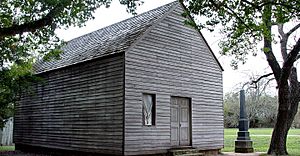Washington-on-the-Brazos, Texas facts for kids
Quick facts for kids
Washington-on-the-Brazos
Washington
|
|
|---|---|

Replica of Independence Hall, where the Texas Declaration of Independence was signed. The inscription reads: "Here a Nation was born."
|
|
| Country | |
| State | |
| County | Washington |
| Elevation | 69 m (226 ft) |
| Time zone | UTC-6 (Central (CST)) |
| • Summer (DST) | UTC-5 (CDT) |
| ZIP code |
77880
|
| Area code(s) | 979 |
| GNIS feature ID | 1349512 |
Washington-on-the-Brazos, often called just Washington, is a small community in Washington County, Texas, United States. It sits right by the Brazos River. This place is super important because it's where Texas officially declared its independence from Mexico. It's like the birthplace of Texas!
The town got its name from Washington, Georgia, which was named after George Washington, a famous American leader. After the American Civil War, people started calling it "Washington-on-the-Brazos." This helped tell it apart from Washington, D.C., which is "Washington-on-the-Potomac."
Contents
The Birthplace of Texas: A Historic Town
Washington-on-the-Brazos has a rich history. It was founded in 1833 by John W. Hall. He was one of the first settlers in the area, known as the "Old Three Hundred." The town was built near a ferry crossing on the Brazos River, which was an important travel route.
Early Growth and the Texas Revolution
Many early settlers came from the southern United States. At that time, Texas was part of Mexico. Because of its location on the river and near main roads, Washington quickly became a busy trading center. More people moved there, making it a lively place.
When the Texas Revolution began, General Sam Houston even set up his headquarters in Washington in December 1835. This shows how important the town was.
Declaring Independence: A New Nation is Born
Washington-on-the-Brazos is famous as "the birthplace of Texas." On March 1, 1836, important leaders from Texas met here. They wanted to officially announce that Texas would separate from Mexico. They also started writing a constitution for the new Republic of Texas.
The delegates signed the Texas Declaration of Independence on March 2, 1836. They finished writing their constitution on March 16. But they had to leave quickly on March 17! The Mexican Army was getting close, and everyone had to flee for safety.
After the Mexican Army was defeated at the Battle of San Jacinto on April 21, the townspeople returned. Leaders hoped Washington would become the permanent capital of the Republic of Texas. However, the leaders chose another place, which later became Austin, Texas.
Changes Over Time: From Boom to Quiet
Washington County was created in 1836. Washington-on-the-Brazos became the county seat in 1837. Even though the county seat moved to Brenham in 1844, Washington continued to be important. It was a major center for the cotton trade until the mid-1850s. The Brazos River was perfect for shipping cotton.
However, new railroads were built that bypassed the town. This meant businesses moved away. The American Civil War also caused many problems for the town. By the early 1900s, Washington-on-the-Brazos was almost empty.
Exploring Washington's Culture and History
Today, Washington-on-the-Brazos is a special place to visit. It's home to the Washington-on-the-Brazos Historical Site. This site has three main attractions that teach visitors about Texas history:
- The Star of the Republic Museum: This museum tells the story of the Texas Republic.
- A replica of Independence Hall: This is where the Texas Declaration of Independence was signed.
- Barrington Plantation: This was the home of Anson Jones, the last president of the Texas Republic.
The town also has the Blessed Virgin Mary Catholic Church. It was founded in 1849 and is the oldest Black Catholic church in Texas.
Washington Avenue in Houston is named after Washington-on-the-Brazos. It was once the main route to this historic county.
Where is Washington-on-the-Brazos Located?
Washington-on-the-Brazos is found in the northeastern part of Washington County. It's about 18 miles (29 km) east of Brenham. It's also about 10 miles (16 km) west of Navasota. The community is located near where the Brazos and Navasota rivers meet.
Learning in Washington: Schools Through the Years
The first school in Washington might have been started by John Hall's wife in 1837. Later, in 1841, a local Masonic Lodge created its own school. There was also a school for girls called the Washington Female Academy for a short time.
In the 1930s, there were two schools, separated by race. Today, students in the community attend schools in the Brenham Independent School District.
Gallery
-
Steamboat exhibit at Star of the Republic Museum
-
Barrington Farm, residence of Anson Jones













